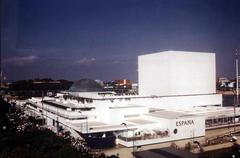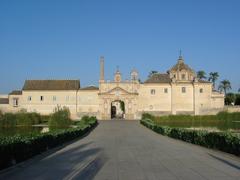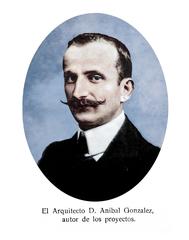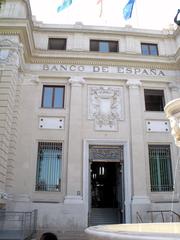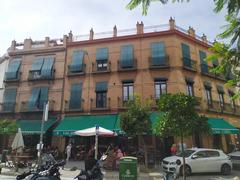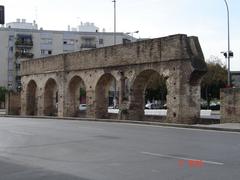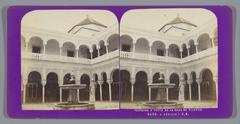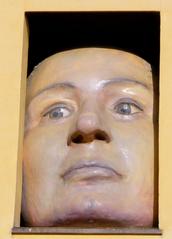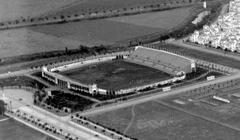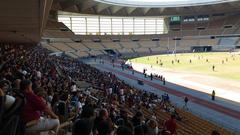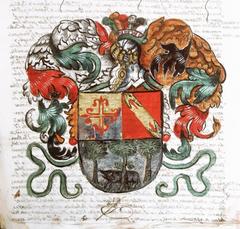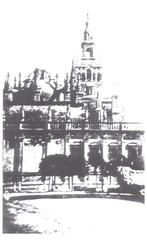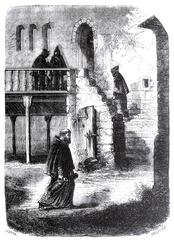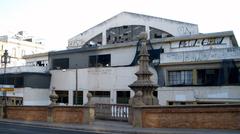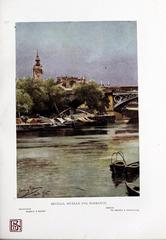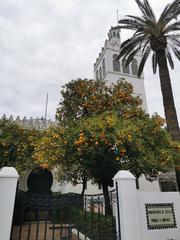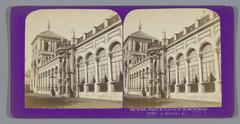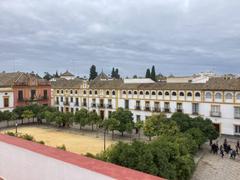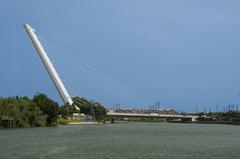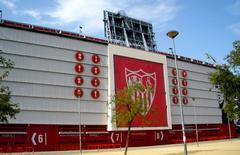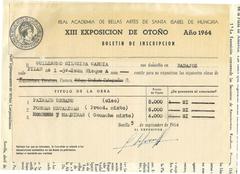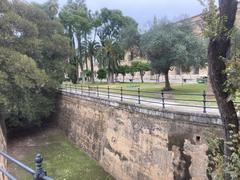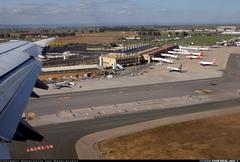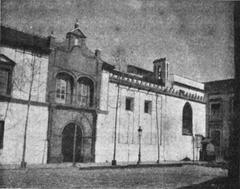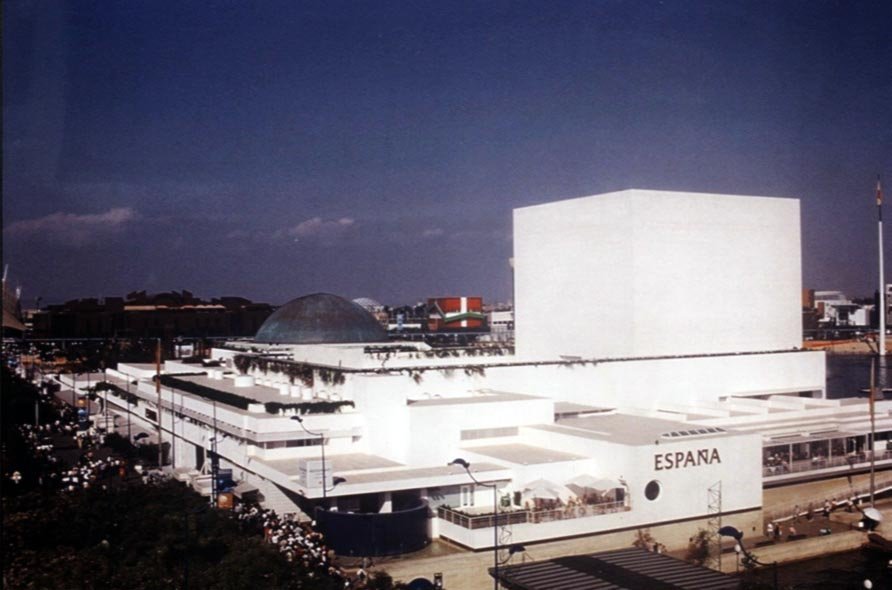
Pabellón de España Expo ‘92 Seville: Visiting Hours, Tickets, and Travel Guide
Date: 14/06/2025
Introduction: The Legacy of Pabellón de España at Expo ‘92
Seville’s Pabellón de España (Spanish Pavilion) is a significant symbol of Spain’s cultural heritage and modern ambitions, rooted in the transformative legacy of Expo ’92. This Universal Exposition marked the 500th anniversary of Columbus’s voyage, acting as a catalyst for Seville’s urban renewal, technological progress, and international cultural exchange. Hosting 111 countries and all of Spain’s autonomous communities, Expo ’92 showcased global innovation and signified Spain’s emergence as a modern European nation after decades of political change (Scribbler in Seville; Politico).
The original Pabellón de España, with its modernist architecture and maritime symbolism, served as the Expo’s flagship structure. Today, although the pavilion no longer exists in its Expo form, its legacy continues through its integration into Isla Mágica theme park and its influence on the revitalized Isla de la Cartuja district. Visitors can explore the pavilion’s enduring heritage through immersive exhibitions, guided tours, and the distinctive urban landscape that arose from Expo ’92 (Oway Tours; Turismo Sevilla).
This guide presents detailed information on visiting hours, tickets, accessibility, cultural highlights, and nearby attractions, ensuring a rewarding experience for anyone interested in Seville’s history, architecture, and Expo ’92 legacy.
Table of Contents
- Introduction
- Historical Context of Expo ‘92
- The Pabellón de España: Architecture and Cultural Impact
- Visiting Today: Hours, Tickets, and Access
- Guided Tours and Visitor Tips
- Facilities and Accessibility
- What to See and Do
- Nearby Attractions
- Practical Travel Tips
- Frequently Asked Questions (FAQ)
- Conclusion
- References and Official Links
Historical Context: Expo ‘92 and Urban Transformation
Following Spain’s transition to democracy, Seville was chosen to host Expo ‘92 as a symbol of renewal and progress. The Expo was timed with the 500th anniversary of Columbus’s voyage, highlighting Spain’s global role in history (Scribbler in Seville). Seville, then a relatively provincial city, underwent a massive transformation:
- Infrastructure Upgrades: €10 billion was invested in a new international airport, six new bridges over the Guadalquivir River, Spain’s first high-speed AVE rail line, and modernized highways and public transport (Politico).
- Expo Grounds: Isla de la Cartuja, previously farmland, was converted into a state-of-the-art fairground, hosting diverse national and regional pavilions (Scribbler in Seville).
The Expo attracted over 41 million visits, fostering a cosmopolitan atmosphere and leaving a lasting economic and cultural legacy.
The Pabellón de España: Architectural and Cultural Highlights
Design and Symbolism
The Pabellón de España, designed by Julio Cano Lasso, featured a bold, modernist design using glass, steel, and water elements to evoke Spain’s maritime heritage. Its geometric forms, reflecting pools, and terraces symbolized the nation’s navigational achievements and cultural diversity (Oway Tours; Turismo Sevilla).
Exhibition Spaces
The pavilion’s interior hosted exhibitions on Spain’s scientific, artistic, and exploratory achievements. Multimedia installations, historical artifacts, and contemporary art displays provided immersive educational experiences (CNN Travel).
Artistic Elements
Notable artworks, such as the “El Torero” statue, were integrated into the structure, reinforcing its cultural identity (Expo92 Blogspot).
Cultural Role
As the host nation’s pavilion, it was central to official ceremonies and diplomatic events, symbolizing Spain’s modern transformation and its openness to the world (Andalucia.com).
Visiting Pabellón de España Today
Location and Access
The pavilion is now part of the Isla Mágica theme park on Isla de la Cartuja, northwest of Seville’s historic center (Isla Mágica). Access is via bus, taxi, or a pleasant walk or bike ride across the Puente de la Barqueta or Puente del Alamillo. Parking is available at Isla Mágica for those arriving by car (World Travel Guide).
Visiting Hours and Tickets
-
Isla Mágica Theme Park:
- Season: April to early November.
- Hours: July–September: 11:00–23:00 (Mon–Fri), 11:00–24:00 (Sat), 11:00–23:00 (Sun). Reduced hours outside peak season.
- Tickets: Adult tickets range from €29 to €35; discounts are available for children, seniors, and families. Online purchase is recommended.
- Access: The pavilion can be visited during park operating hours; independent access is generally not available.
-
Pabellón de la Navegación Museum: Nearby, this museum is open Tuesday to Sunday, 10:00–19:00. Tickets are around €6 for adults.
More details are available on the Isla Mágica official website and the Pabellón de la Navegación Museum site.
Guided Tours and Special Visits
- Asociación Legado Expo Sevilla offers free guided tours of the Expo ’92 site, including Pabellón de España and other surviving pavilions. These require advance registration and are typically conducted in Spanish (Asociación Legado Expo Sevilla; ABC Sevilla).
- Private and Educational Visits: Groups and schools can arrange special tours by contacting the Parque Científico y Tecnológico Cartuja.
Facilities and Accessibility
- Restrooms: Available within Isla Mágica and the pavilion during events.
- Dining: Several cafes and restaurants are located in Isla Mágica and the Cartuja district.
- Shaded Areas: The pavilion features shaded patios and water features for comfort in the summer heat.
- Accessibility: Isla Mágica and the pavilion provide ramps, wide pathways, and services for visitors with reduced mobility (Canolasso Arquitectos).
What to See and Do
- Architectural Highlights: Admire the pavilion’s minimalist design, interconnected courtyards, and use of marble, lime, and ceramics.
- Expo 92 Legacy Exhibits: Discover interpretive panels and exhibitions on the history of Expo ’92 and the transformation of Isla de la Cartuja.
- Isla Mágica Attractions: The pavilion is part of the “Puerta de América” area, acting as a thematic centerpiece for historical and adventure rides.
- Photography: Capture the unique interplay of light and shadow, geometric shapes, and water features.
Practical Travel Tips
- Best Visiting Seasons: Spring (April–June) and autumn (September–October) offer mild weather. Summers are hot—visit early and use shaded areas.
- Tickets: Buy Isla Mágica tickets online in advance for convenience and better rates. For guided tours, consult the Asociación Legado Expo Sevilla.
- Dress Code: Comfortable shoes, light clothing, and sun protection are advised.
- Languages: Most tours and signage are in Spanish; basic Spanish phrases are helpful.
- Security: The area is safe, but remain mindful of personal belongings.
Nearby Attractions
- Pabellón de la Navegación: Maritime museum with interactive exhibits (El Pespunte).
- Torre Pelli and CaixaForum: Modern cultural landmarks nearby.
- Historic Center: The Seville Cathedral, Alcázar, and Plaza de España are all within easy reach (World Travel Guide).
Frequently Asked Questions (FAQ)
Q: Can I visit the Pabellón de España without Isla Mágica admission?
A: No. The pavilion is inside Isla Mágica; access is included with park admission. Special guided tours may provide alternative access.
Q: Are English-language tours available?
A: Most guided tours are in Spanish; check with providers for English options.
Q: Is the pavilion accessible for visitors with reduced mobility?
A: Yes, ramps and wide pathways are available.
Q: Where can I find up-to-date opening hours?
A: Visit the Isla Mágica website for seasonal hours.
Q: What are the best photography spots?
A: Courtyards, arcades, water features, and areas with dynamic lighting.
Conclusion
The Pabellón de España stands as a vibrant testament to Seville’s transformation during Expo ’92 and Spain’s broader cultural renaissance. Its architectural grandeur and symbolic resonance continue to draw visitors, offering a unique blend of history, leisure, and urban innovation. Plan your visit for spring or autumn, purchase tickets online, and take advantage of guided tours for a comprehensive experience. The pavilion’s integration into Isla Mágica exemplifies how cultural heritage can be preserved and adapted for modern enjoyment.
For a deeper exploration, download the Audiala app for curated guides and the latest updates, and connect with Seville’s rich past and dynamic present.
References and Further Reading
- Scribbler in Seville: Expo ‘92 20 Years On
- Politico: Seville Raised from Improbable World Fair Phoenix
- Oway Tours: Los Pabellones de la Expo 92 Sevilla
- Turismo Sevilla: Pavilions 1992 Universal Exhibition
- Pabellón de la Navegación Museum
- Isla Mágica Theme Park Official Site
- Asociación Legado Expo Sevilla
- CNN Travel: Discover Seville’s Expo ’92 Legacy
- World Travel Guide: Things to See in Seville
- El Pespunte: El legado vivo de la Expo del 92 de Sevilla
- Canolasso Arquitectos: Pabellón de España en la Expo 92
- ABC Sevilla: Visitas guiadas gratuitas Expo92 Sevilla
- Parque Científico y Tecnológico Cartuja
